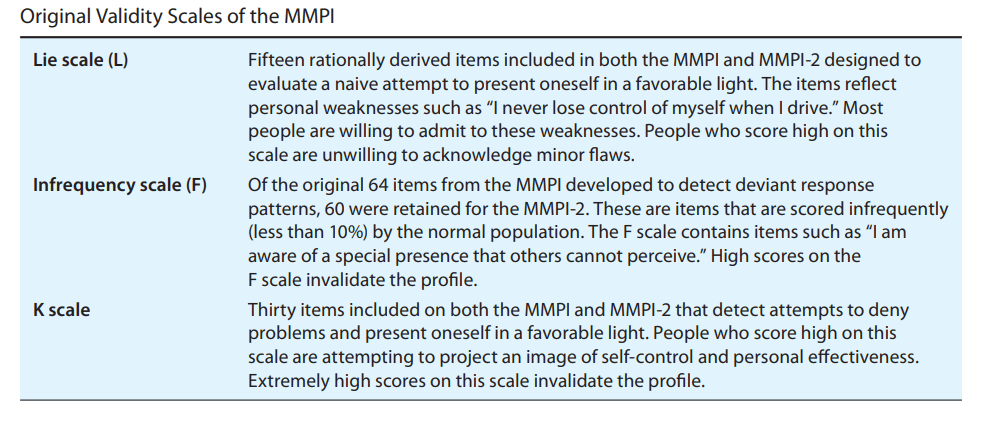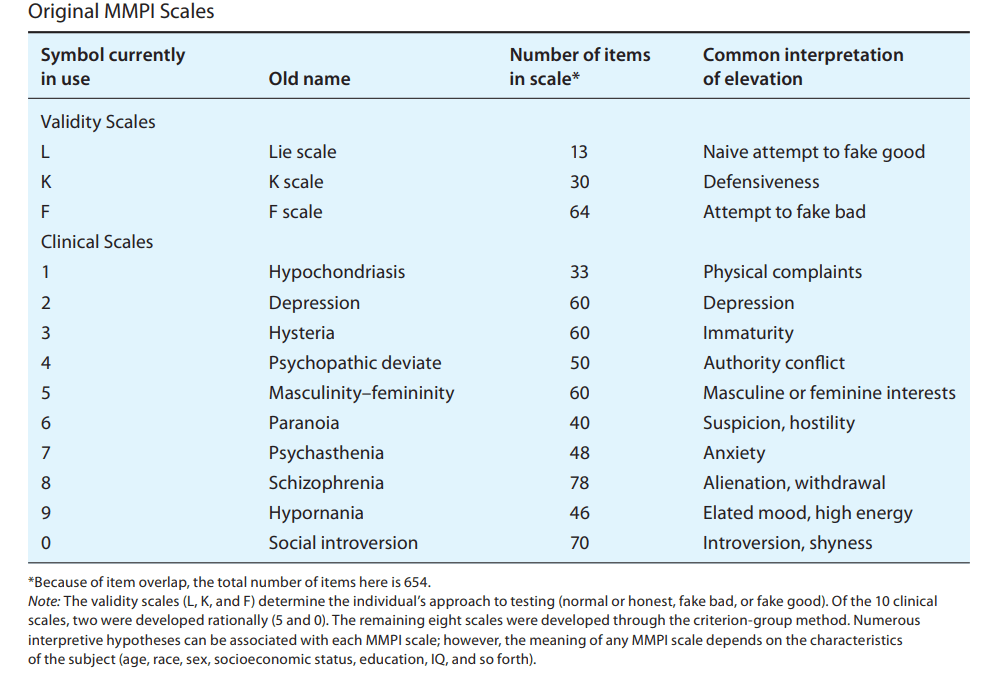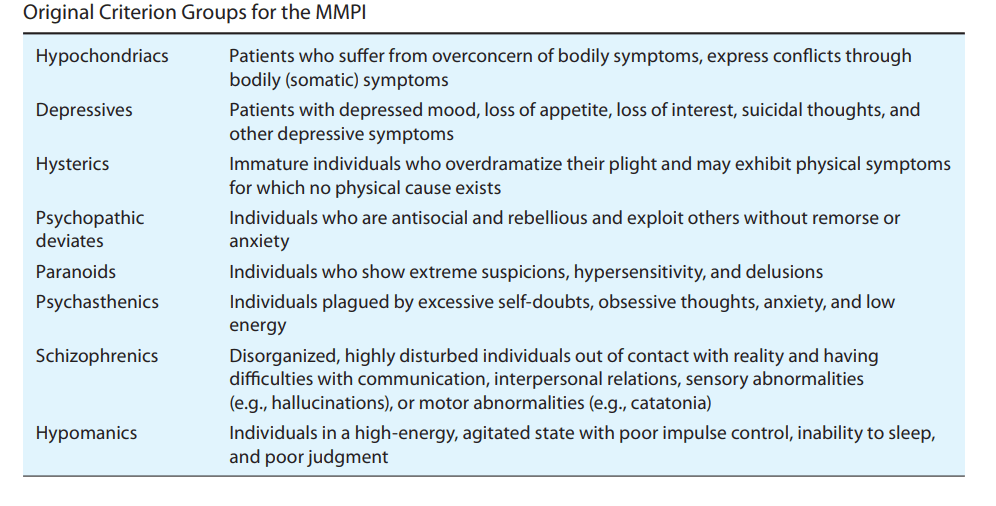Introduction
The Minnesota Multiphasic Personality Inventory (MMPI) is one of the most extensively used psychological tests designed to assess personality traits and identify psychopathology. Developed in the late 1930s and 1940s by Starke Hathaway (a psychologist) and J.C. McKinley (a physician), it revolutionized psychological testing by introducing the empirical criterion-group strategy (Kaplan & Saccuzzo, 2008). Over the years, it has undergone several revisions, resulting in updated versions such as the MMPI-2 and MMPI-2-RF to ensure contemporary relevance and improved psychometric properties.
Development and Structure of the MMPI
Hathaway and McKinley developed the MMPI with a pool of 1,000 items, sourced from-
- Case histories.
- Psychological reports.
- Textbooks and earlier tests.
Through empirical validation, 504 items were chosen, which could differentiate between clinical groups (individuals diagnosed with psychological disorders) and control groups (relatives or visitors of patients). The primary goal was to distinguish normal from abnormal behavior and to provide a diagnostic framework for psychological disorders (Kaplan & Saccuzzo, 2008).
The purpose of MMPI is-
- Assist in diagnosing major psychiatric disorders.
- Provide a comprehensive understanding of personality functioning.
- Evaluate individuals in clinical, forensic, and occupational settings.
Key Innovations in MMPI
- The empirical criterion-group strategy was pivotal, as items were retained based solely on their statistical ability to discriminate between groups. This approach avoided assumptions about item content.
- Unlike earlier tests relying on face validity, MMPI developers assumed no inherent meaning to test responses and relied on data-driven differentiation.
The MMPI consists of true-false statements, which respondents answer based on self-assessment. Scores are converted to T-scores, with a mean (M) of 50 and a standard deviation (SD) of 10- Scores above 65 in MMPI-2 are considered clinically significant (Kaplan & Saccuzzo, 2008).

MMPI- Minnesota Multiphasic Personality Inventory Profile Sheet
Versions of the MMPI-Minnesota Multiphasic Personality Inventory
There have been multiple revisions to MMPI, the current edition is MMPI 3.
- MMPI (1943)– The original test had 566 items and focused on 10 clinical scales. It served as a diagnostic tool for mental health professionals but had limitations, including an unrepresentative normative sample and culturally outdated language.
- MMPI-2 (1989)– Expanded to 567 items to address criticisms of the original MMPI. Incorporated a normative sample representative of U.S. demographics. Added new validity scales and content scales to improve diagnostic accuracy and address a broader range of clinical and behavioral issues.
- MMPI-2-RF (2008)– Reduced to 338 items to improve efficiency and focus. Designed to address redundancy and overlapping scales in MMPI-2. Provided more distinct constructs and enhanced interpretability.
- MMPI-3 (2020)- Elaborated below.
Read More- Personality
Scales of the MMPI-Minnesota Multiphasic Personality Inventory
The MMPI comprises three primary types of scales- Validity Scales, Clinical Scales, and Content Scales. These scales collectively evaluate personality traits, emotional functioning, and response styles.

Validity Scales of MMPI Minnesota Multiphasic Personality Inventory
Validity Scales
The validity scales assess the respondent’s approach to the test, including efforts to misrepresent, exaggerate, or randomly answer items. These include-
- Lie (L) Scale- Detects deliberate attempts to appear overly virtuous or moral. For example- “I never lose my temper”. Elevated scores indicate defensiveness or denial of flaws.
- Infrequency (F) Scale- Identifies rare or atypical responses. For example- “I hear voices others cannot hear.” High scores may suggest malingering, severe distress, or confusion.
- Defensiveness (K) Scale- Measures subtle defensiveness or denial of problems. High scores reflect reluctance to admit difficulties, while low scores suggest openness.
- Variable Response Inconsistency (VRIN) Scale- Detects random answering by comparing pairs of similar or contradictory items. For example Pair like “I feel sad” and “I am unhappy.”
- True Response Inconsistency (TRIN) Scale- Identifies fixed response biases, such as answering “true” to most questions regardless of content.
- Cannot Say (?)- Tracks omitted items. High omissions (greater than 10%) can invalidate the test.
Clinical Scales
The 10 clinical scales are the foundation of the MMPI, designed to assess major psychological syndromes.

- Hypochondriasis (Hs)- Measures preoccupation with health and somatic (physical) complaints, often indicating health anxiety. High scores suggest excessive worry about health and frequent physical complaints, even in the absence of medical findings.
- Depression (D)- Assesses feelings of sadness, hopelessness, and a lack of motivation, which are hallmarks of depressive states. High scores indicate severe feelings of hopelessness, sadness, and depressive symptoms, reflecting emotional distress and low energy.
- Hysteria (Hy)- Measures emotional overreaction, denial of emotional distress, and physical complaints without a medical cause. High scores suggest the person may present with dramatic physical symptoms and minimize underlying emotional distress.
- Psychopathic Deviate (Pd)- Examines antisocial behaviors, rebelliousness, and impulse control issues. High scores indicate tendencies to break social rules, lack empathy, and demonstrate antisocial behaviors, such as impulsivity or rebelliousness.
- Masculinity-Femininity (Mf)- Explores interests, behaviors, and attitudes that are traditionally associated with gender roles (masculine or feminine). High scores suggest nonconformity to traditional gender roles and may reflect a rejection of stereotypical gender expectations.
- Paranoia (Pa)- Measures suspiciousness, mistrust, and potential delusional thinking. High scores indicate excessive mistrust or feelings of victimization, as well as possible paranoid or delusional tendencies.
- Psychasthenia (Pt)- Focuses on anxiety, obsessive thoughts, and feelings of inadequacy, often linked to generalized anxiety or obsessive-compulsive behaviors. High scores reflect chronic anxiety, obsessive thoughts, and self-doubt, suggesting an individual feels tense or inadequate.
- Schizophrenia (Sc)- Assesses symptoms related to schizophrenia, such as disorganized thinking, emotional withdrawal, and perceptual disturbances. High scores suggest bizarre thoughts, psychotic symptoms, and disorganized thinking, with possible withdrawal from social interaction.
- Hypomania (Ma)- Measures elevated energy, impulsivity, and hyperactivity, often indicative of a manic state. High scores indicate traits like grandiosity, impulsive behavior, or overactivity, reflecting a tendency to be overly energetic or impulsive.
- Social Introversion (Si)- Assesses tendencies toward social withdrawal, discomfort in social settings, and shyness. High scores suggest a preference for solitude, social anxiety, or avoidance of social interaction, as well as a general sense of discomfort in group settings.
Content Scales
Introduced with the MMPI-2, Content Scales offer deeper insights into specific areas of functioning, helping clinicians understand the context of psychological distress.
- HEA (Health Concerns)- Focuses on preoccupation with health issues.
- FAM (Family Problems)- Measures conflicts and dissatisfaction within family relationships.
- WRK (Work Interference)- Assesses attitudes and behaviors affecting job performance.
- ANG (Anger)- Identifies irritability and poor anger control.
- ANX (Anxiety)- Captures worry and emotional tension.
Minnesota Multiphasic Personality Inventory- MMPI-3
The MMPI-3, released in 2020, represents the most significant update to the MMPI series in decades. It retains the core features of earlier versions but incorporates modern developments in psychology and test construction.
The key Features of MMPI-3 include-
- Updated Normative Sample- Norms were derived from a nationally representative U.S. sample that includes diverse racial, ethnic, and socioeconomic groups to ensure fairness and applicability.
- Streamlined Structure- Reduced to 335 items, allowing for quicker administration while maintaining robust psychometric properties.
- Enhanced Validity Scales- New and revised scales address response patterns, including those specific to malingering and exaggeration in forensic contexts.
- Expanded Scales for Modern Issues- New content areas include behavioral tendencies related to technology use, stress, and adjustment to contemporary challenges.
- Improved Psychometric Properties- Focus on construct validity, ensuring that each scale measures distinct psychological constructs without excessive overlap.
New and Revised Scales in MMPI-3
- EID (Emotional/Internalizing Dysfunction)- Combines anxiety and depression into a single domain for clarity in understanding emotional distress.
- THD (Thought Dysfunction)- Measures disorganized thinking and detachment from reality, tailored to modern diagnostic criteria for psychosis.
- BXD (Behavioral/Externalizing Dysfunction)- Evaluates impulsivity, aggression, and risk-taking behaviors.
- RC Scales (Restructured Clinical Scales)- Further refined to minimize overlap and increase interpretive precision.
Criterion Group Strategy in MMPI
The Minnesota Multiphasic Personality Inventory (MMPI) is a prime example of the criterion-group strategy in psychological test construction. This strategy involves selecting test items based on their ability to differentiate between groups of individuals with specific characteristics (criterion groups) and those without those characteristics (control groups).

In the case of the MMPI, the developers, Starke Hathaway and J.C. McKinley, created a large pool of test items and then tested these items on groups of individuals with various psychological conditions (e.g., depression, schizophrenia) as the criterion groups. These groups were compared to control groups of individuals without those conditions, typically relatives or non-psychiatric hospital visitors. The items that were endorsed more frequently by the criterion group than the control group were selected for inclusion in the test.
For example, if individuals with depression endorsed an item like “I feel sad much of the time” significantly more than individuals in the control group, that item would be retained for the depression scale. This method ensures that the MMPI is empirically validated and based on data, not assumptions, making it an objective and reliable tool for diagnosing psychological disorders.
Psychometric Properties of MMPI
The Minnesota Multiphasic Personality Inventory (MMPI), including its revised versions (MMPI-2 and MMPI-3), is known for its strong psychometric properties. Psychometric properties refer to the reliability, validity, and overall effectiveness of a psychological test.
Reliability Minnesota Multiphasic Personality Inventory (MMPI)
Reliability refers to the consistency of a test’s results over time, across different populations, and in various testing conditions.
- Test-Retest Reliability- This measures the stability of the MMPI over time. The MMPI shows moderate to high test-retest reliability, meaning that individuals’ results on the MMPI are relatively consistent when tested multiple times, assuming no significant changes in their psychological state occur. Test-retest coefficients for the MMPI-2 typically range from 0.60 to 0.90, depending on the specific scales. Higher values are often seen in clinical scales, such as Hypochondriasis (Hs) and Depression (D), while lower coefficients may be observed for scales measuring more transient states.
- Internal Consistency- Internal consistency refers to how well the items within each scale are related to one another. The MMPI generally shows high internal consistency across its scales. The Cronbach’s alpha values (a measure of internal consistency) for the MMPI-2 scales typically range from 0.80 to 0.90, suggesting good internal reliability for most clinical and validity scales. Some subscales may have slightly lower values, particularly those measuring more specific aspects of psychopathology.
- Inter-rater Reliability- Inter-rater reliability assesses the consistency of results when different clinicians score or interpret the test. The MMPI has good inter-rater reliability, ensuring that different clinicians can interpret test results in a similar manner when following established guidelines for scoring and interpreting profiles.
Validity of Minnesota Multiphasic Personality Inventory (MMPI)
Validity refers to how well the test measures what it is supposed to measure and whether it can accurately predict outcomes.
- Construct Validity- Construct validity is the extent to which the MMPI measures psychological constructs (such as depression or anxiety) that it is intended to assess. The MMPI demonstrates strong construct validity because its clinical scales were developed using the criterion-group method, which ensured they reliably measure specific psychological conditions by differentiating between groups with and without the condition. Factor analyses of the MMPI have consistently revealed that it assesses two primary factors- internalizing (e.g., anxiety, depression) and externalizing (e.g., aggression, antisocial behavior) dysfunctions, supporting its construct validity.
- Content Validity- Content validity assesses whether the items on the test represent the entire spectrum of the construct being measured. Given its development through extensive item pools and empirical analysis with specific criterion groups, the MMPI has strong content validity, as the items on each scale relate to the specific conditions they are intended to assess.
- Criterion-related Validity- Criterion-related validity refers to how well the MMPI correlates with other established measures of the same construct (i.e., its ability to predict real-world outcomes). The MMPI demonstrates good criterion-related validity. For instance, studies have shown that high scores on scales like depression (Scale 2) correlate with other measures of depression, such as clinical interviews or diagnostic assessments. It also predicts outcomes like treatment response and psychological functioning across various settings (clinical, forensic, and occupational).
- Predictive Validity- The ability of the MMPI to predict future behaviors, such as the likelihood of developing certain disorders or engaging in maladaptive behaviors, is also well-established. For example, the MMPI has been used to predict substance abuse and violent behavior in forensic settings.
Strengths and Weaknesses of Reliability Minnesota Multiphasic Personality Inventory (MMPI)
The strengths and weaknesses of MMPI include-
Strengths
- Empirical Validation- The empirical criterion-group strategy ensures the test is data-driven and free from assumptions, enhancing its reliability and validity.
- Breadth of Assessment- The MMPI series covers a wide range of psychological traits and disorders, making it versatile across clinical, forensic, and occupational domains.
- Continuous Updates- Revisions like MMPI-2, MMPI-2-RF, and MMPI-3 address criticisms and incorporate advances in psychology to maintain relevance.
- Utility in Diverse Settings- Used for diagnosing mental disorders, evaluating personality traits, and screening candidates for high-stakes professions like law enforcement or the military.
- Cross-Cultural Applicability- MMPI-3’s updated norms address cultural diversity, ensuring fair application across various demographic groups.
Weaknesses
- Length of Earlier Versions- The MMPI-2’s 567 items can cause respondent fatigue, though MMPI-3 addresses this with its reduced item count.
- Interpretation Complexity- High intercorrelations between scales and the need for professional expertise can make results challenging to interpret.
- Cultural Sensitivity Issues- While recent revisions address these concerns, the original MMPI faced criticism for being normed on a predominantly White, U.S.-based population.
- Potential for Response Bias- Fixed true/false response options can lead to acquiescence or defensiveness if not monitored through validity scales.
Conclusion
The MMPI remains a gold standard in psychological testing, offering clinicians, researchers, and legal professionals a robust and reliable tool for assessing psychological functioning. Its continued relevance is supported by its ongoing revisions, which ensure that the test adapts to the ever-evolving field of psychology, providing valuable insights into the mental health of individuals across diverse settings.
References
Kaplan, R. M., & Saccuzzo, D. P. (2008). Psychological Testing: Principles, Applications, and Issues. Wadsworth Publishing.
Subscribe to Careershodh
Get the latest updates and insights.
Join 18,524 other subscribers!
Niwlikar, B. A. (2024, December 2). MMPI- Minnesota Multiphasic Personality Inventory & Its 3 Important Scales. Careershodh. https://www.careershodh.com/mmpi-minnesota-multiphasic-personality-inventory/
